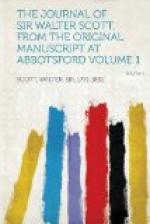[124] [Sir Walter’s private law-agent.] Mr. John Gibson, Junr., W.S., Mr. James Jollie, W.S., and Mr. Alexander Monypenny, W.S., were the three gentlemen who ultimately agreed to take charge, as trustees, of Sir Walter Scott’s affairs; and certainly no gentlemen ever acquitted themselves of such an office in a manner more honourable to themselves, or more satisfactory to a client and his creditors.—J.G.L. Mr. Gibson wrote a little volume of Reminiscences of Scott, which was published in 1871. This old friend died in 1879. “In the month of January 1826,” says Mr. Gibson, “Sir Walter called upon me, and explained how matters stood with the two houses referred to, adding that he himself was a partner in one of them—that bills were falling due and dishonoured—and that some immediate arrangement was indispensably necessary. In such circumstances, only two modes of proceeding could be thought of—either that he should avail himself of the Bankrupt Act, and allow his estate to be sequestrated, or that he should execute a trust conveyance for behoof of his creditors. The latter course was preferred for various reasons, but chiefly out of regard for his own feeling.” Reminiscences, p. 12. See entry in Journal under Jan. 24.
[125] Sir John Hope of Pinkie and Craighall, 11th Baronet; Sir Henry Jardine, King’s Remembrancer from 1820 to 1837; and Sir William Rae, Lord Advocate, son of Lord Eskgrove, were all Directors of the Royal Bank of Scotland.
[126] John Prescott Knight, the young artist referred to, afterwards R.A., and Secretary to the Academy, wrote (in 1871) to Sir William Stirling Maxwell, an interesting account of the picture and its accidental destruction on the very day of Sir Walter’s death. Scott Exhibition Catalogue, 4to, Edin. p. 199. Mr. Knight died in 1881.
[127] To hain anything is, Anglice, to deal very carefully, penuriously about it—tyne, to lose. Scott often used to say “hain a pen and tyne a pen,” which is nearer the proverb alluded to.—J.G.L.
[128] The late Sir William Forbes, Baronet, succeeded his father (the biographer of Beattie) as chief of the head private banking-house in Edinburgh. Scott’s amiable friend died 24th Oct. 1828.—J.G.L.
[129] John Adam, Esq., died on shipboard on his passage homewards from Calcutta, 4th June 1825.—J.G.L.
[130] The Right Hon. W. Adam of Blairadam, born in 1751. When trial by Jury in civil cases was introduced into Scotland in 1815, he was made Chief Commissioner of the Jury Court, which office he held till 1830.
Mr. Lockhart adds (Life, vol. v. p. 46): “This most amiable and venerable gentleman, my dear and kind friend, died at Edinburgh, on the 17th February 1839, in the 89th year of his age. He retained his strong mental faculties in their perfect vigour to the last days of this long life, and with them all the warmth of social feelings which had endeared him to all who were so happy as to have any opportunity of knowing him.”




